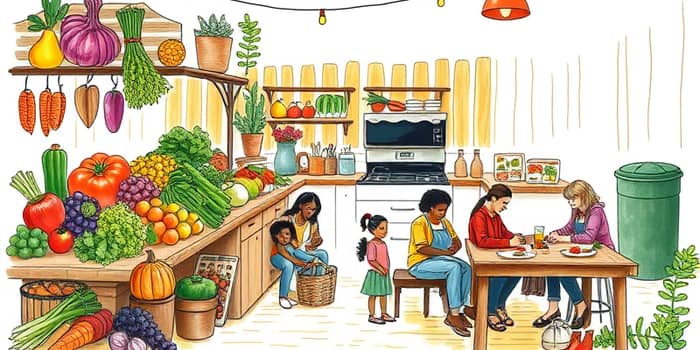Every year, our plates are at the center of a crisis that touches every corner of the planet. Understanding how food waste affects our environment, wallets, and communities can spark a transformation in how we source and prepare meals.
In this article, we explore the dimensions of food waste, the benefits of eating local, and the art of meal planning. By the end, you’ll have practical strategies for lasting change that can save money and reduce environmental impact.
The Food Waste Crisis and Its Consequences
Every year, nearly 30-40% of the food supply in the United States is wasted before it even reaches our mouths, amounting to about 60 million tons. On a global scale, roughly 931 million tons of edible food is lost or discarded each year.
Households contribute nearly half of this waste stream. In US homes, families dispose of 43% of the food they bring in, resulting in an average loss of over $3,000 per household yearly. Beyond the financial losses, the environmental toll is significant—food waste in landfills releases methane, a greenhouse gas nearly 30 times more potent than carbon dioxide. In fact, 20% of US methane emissions originate from landfills.
By working together and adopting smarter habits, individuals and communities can help retailers achieve remarkable reductions. One study found that targeted waste reduction efforts led to a 30% drop in related greenhouse gases over just three years.
Governments worldwide have recognized this challenge. The US, along with the UN, aims to cut food waste by 50% by 2030. State and local policies are already emerging to enforce composting, donate surplus food, and provide incentives for waste tracking and prevention. These measures show promising results but rely on individual support and participation to reach their full potential.
Why Eat Local
Choosing foods grown within your region does more than support farm economies—it supports area farmers and producers, ensuring that every dollar circulates within your community. Local distribution chains shorten the time between harvest and plate, preserving peak flavor and nutrient content.
Local food often travels only a few miles from farm to table, which preserves flavor and nutrients. Seasonal eating also introduces diversity in diets and reconnects us with natural growing cycles. When consumers embrace seasonal produce, they help stabilize farm incomes throughout the year.
Reduced transportation also means less packaging and lower greenhouse gas output. Buying local often means less plastic packaging and simpler supply chains. When you choose a farmers market or a local grocery cooperative, you help build a food system that values freshness, accountability, and resilience.
Harnessing the Power of Meal Planning
Effective meal planning transforms groceries from potential waste to nourishing meals. When you map out your week’s menu, you avoid unexpected purchases and can tailor shopping lists to precise ingredient needs. Thoughtful planning also fosters healthier eating patterns, as you’re less likely to resort to processed convenience foods.
- Craft a weekly grocery list that matches actual meals
- Practice batch cooking to use ingredients efficiently
- Portion meals to avoid leftovers going uneaten
- Give second life to scraps with creative recipes
Research shows that households implementing structured meal plans can reduce food waste by as much as 15-20%, unlocking savings that offset the time investment in planning.
Meal planning also fosters creativity in the kitchen. When confronted with similar ingredients across multiple dishes, you experiment with different cuisines and techniques. Batch preparation can turn time-consuming tasks like peeling, chopping, and seasoning into efficient group activities—freeing up evenings for family time.
With a plan in hand, you can better use of leftovers and portions while enjoying the confidence that comes from knowing exactly what you’ll cook each night. Over time, this habit strengthens cooking skills and confidence in trying new recipes.
Policy Shifts and Community Initiatives
Legislation and collective action have driven substantial progress. Vermont’s Universal Recycling Law banned food scraps from landfills, leading to an increased food donations by 40 percent and a surge in community composting programs. Similar mandates in cities and states encourage compost collection and underpin new markets for organic soil amendments.
- Pacific Coast Food Waste Commitment shares data and best practices
- US Food Waste Pact unites retailers in donations and composting
- Expanded municipal compost programs reduce landfill reliance
Private businesses are taking note. Restaurants partner with apps to recapture surplus meals, redirecting them to shelters and food banks. Some chefs even curate special menus of imperfect or surplus produce, celebrating ingredients that would otherwise go unused. These collaborations demonstrate that policy frameworks, when paired with innovative business models, can unlock new value chains and reduce environmental burdens.
The Bigger Picture of Sustainable Consumption
Aligned with the UN Sustainable Development Goals, especially Goal 12 on responsible consumption, local eating and meal planning contribute to a circular economy. Every meal crafted and consumed intentionally strengthens the link between producers and consumers, reduces externalities, and keeps resources in a continuous loop of use and reuse.
In a circular economy model, organic waste is treated as a resource, returning nutrients to the soil through compost or bioenergy production. Local food hubs and cooperatives play a crucial role in facilitating these loops, often using technology platforms to match supply and demand in real time.
Communities that embrace local sourcing and waste reduction models see long-term benefits: healthier soils, cleaner water, and robust local economies. By choosing behaviors that promote sustainable agricultural practices, we honor the earth’s limits and pave the way for future generations. Education and outreach programs deepen public understanding of the lifecycle of food, encouraging shifts toward zero-waste events and community composting days.
Actions You Can Take Today
No action is too small. Simple adjustments in shopping, cooking, and disposal habits can shift the needle on waste, greenhouse gases, and community health. Beyond personal choices, lookout for opportunities to advocate policy change. Attend city council meetings to support composting ordinances. Write to representatives about funding for food recovery infrastructure. Your voice can help scale systems that tackle food insecurity and climate change in tandem.
- Visit farmers markets or join a community supported agriculture program
- Plan family meals using a shared calendar or app
- Support restaurants and stores with waste reduction policies
- Compost kitchen scraps or volunteer in local food rescue initiatives
By adopting these approaches, each of us can play a vital role in a larger movement toward sustainable consumption and production. Starting today, let’s embrace practical strategies for lasting change that enrich our communities and protect our planet.
Each action, from a single meal planning session to organizing a community workshop, ripples outward. By building a culture that values food as a treasured resource, we forge healthier communities and a thriving planet.
References
- https://www.rts.com/resources/guides/food-waste-america/
- https://refed.org/articles/looking-ahead-our-2025-food-waste-forecast/
- https://www.therestauranthq.com/trends/restaurant-food-waste-statistics/
- https://ecology.wa.gov/waste-toxics/reducing-recycling-waste/organics-and-food-waste/sustainable-food-center/use-food-well-washington-plan
- https://foodfinders.org/2022/08/03/stop-wasting-food-plan-it-out/
- https://www.un.org/sustainabledevelopment/sustainable-consumption-production/
- https://media.market.us/food-waste-statistics/










